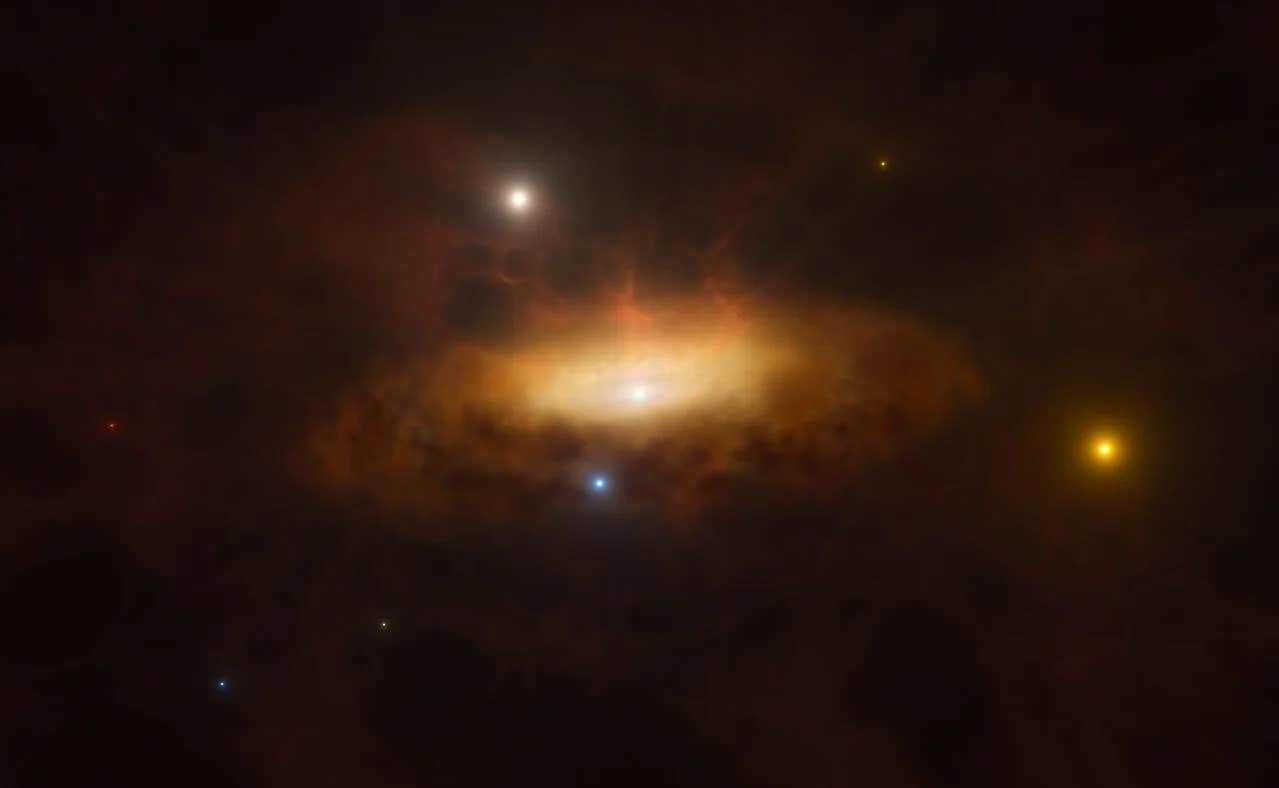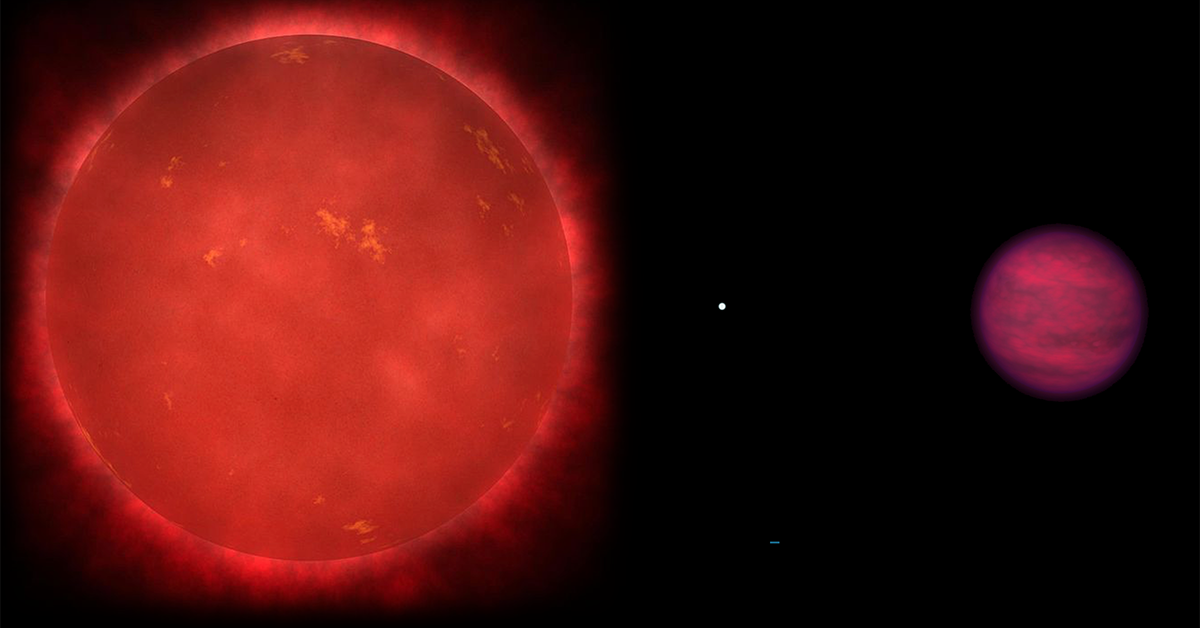Astronomers witness the dramatic awakening of a supermassive black hole
This phenomenon is unfolding in a galaxy known as SDSS1335+0728, situated 300 million light-years away in the Virgo constellation.

Artist’s impression: the galaxy SDSS1335+0728 lighting up. (CREDIT: ESO/M. Kornmesser)
Astronomers have recently uncovered a remarkable and unprecedented event in the vast expanse of space: the sudden awakening of a supermassive black hole at the center of a distant galaxy. This phenomenon is unfolding in a galaxy known as SDSS1335+0728, situated 300 million light-years away in the Virgo constellation.
In late 2019, the galaxy's unexpected spike in brightness was detected by the Zwicky Transient Facility's (ZTF) telescope at the Palomar Observatory in California. The ZTF, equipped with an extensive wide-field camera, surveys the northern sky every two days. This comprehensive scan helps capture a range of celestial phenomena, from nearby asteroids to distant supernovas.
Intrigued by this sudden change in brightness, a team of astronomers and engineers began a detailed follow-up using data from both space- and ground-based telescopes. Their goal was to understand how the galaxy's luminosity evolved over time. To their astonishment, they found themselves witnessing a rare cosmic event: a dormant giant, a supermassive black hole, was coming to life. These findings have been accepted for publication in the journal Astronomy & Astrophysics.
"Imagine you've been observing a distant galaxy for years, and it always seemed calm and inactive," explained Paula Sánchez Sáez, lead author of the study and an astronomer at the European Southern Observatory in Germany. "Suddenly, its core starts showing dramatic changes in brightness, unlike any typical events we've seen before."
The team identified the galaxy's core as an active galactic nucleus—a region that shines brightly due to the energy emitted by a supermassive black hole. Various cosmic events can cause a galaxy to suddenly brighten.
These include supernova explosions or tidal disruption events, where stars venture too close to black holes and get torn apart. However, such events usually only last from days to a few years. In contrast, SDSS1335+0728 has been steadily increasing in brightness for over four years, a unique behavior that left astronomers puzzled.
Related Stories
- First ever "rogue" black hole found roaming through interstellar space
- Scientists uncover how close you can get to a black hole?
- There are 40 billion billions of black holes in the universe
To unravel this mystery, the researchers turned to historical data from several observatories, including NASA’s Wide-field Infrared Survey Explorer, the Galaxy Evolution Explorer, the Two Micron All Sky Survey, and the Sloan Digital Sky Survey.
They also gathered recent observations from the European Southern Observatory's Very Large Telescope (VLT) in Chile, the Southern Astrophysical Research Telescope in Chile, the W. M. Keck Observatory in Hawaii, and NASA’s space-based Neil Gehrels Swift and Chandra X-ray observatories.
By piecing together these datasets, the researchers created a comprehensive timeline of the galaxy's behavior before and after the December 2019 observation. They discovered that the galaxy had begun to emit significantly more ultraviolet, visible, and infrared light in recent years, along with a surge in X-ray emissions starting in February. "This shift to emit more light across different wavelengths is unprecedented behavior," noted Sánchez Sáez.
Considering the galaxy's vast distance from Earth, these observed events actually occurred 300 million years ago, but the light from these events is only now reaching us. A light-year, the distance light travels in one year, is about 5.88 trillion miles (9.46 trillion kilometers).
"The most plausible explanation is that we are witnessing the core of the galaxy beginning to show significant activity," said Lorena Hernández García, a coauthor of the study and an astronomer at the Millennium Institute of Astrophysics and the University of Valparaíso in Chile. "If so, this would be the first time that we see the activation of a massive black hole in real time."
Supermassive black holes, which are typically more than 100,000 times the mass of our sun, are found at the centers of most galaxies, including our Milky Way. "These giant monsters usually lie dormant and are not directly visible," explained Claudio Ricci, another coauthor and an associate professor at Diego Portales University in Chile. "In the case of SDSS1335+0728, we were able to observe the awakening of the massive black hole, which suddenly started to feast on gas in its surroundings, becoming very bright."
While past research has indicated that inactive galaxies can become active after several years, usually due to black hole activity, the direct observation of a black hole awakening, as seen in this study, is a first. Hernández García added, "The process of a black hole transitioning from dormant to active has never been directly observed before until now."
This phenomenon might also be observed with Sagittarius A*, the supermassive black hole at the center of the Milky Way, though it’s uncertain how likely this is to occur, according to Ricci.
Despite the compelling evidence, astronomers cannot completely rule out other possibilities, such as a particularly slow tidal disruption event or an unknown type of celestial activity.
"Regardless of the cause, this galaxy provides valuable insights into how black holes grow and evolve," Sánchez Sáez remarked. "We anticipate that future observations with instruments like the Multi Unit Spectroscopic Explorer (MUSE) on the VLT or those on the upcoming Extremely Large Telescope will be crucial in understanding why the galaxy is brightening."
This discovery not only highlights the incredible dynamism of our universe but also opens up new avenues for understanding the life cycles of galaxies and their enigmatic central black holes.
Note: Materials provided above by The Brighter Side of News. Content may be edited for style and length.
Joshua Shavit
Science & Technology Writer
Joshua Shavit is a Los Angeles-based science and technology writer with a passion for exploring the breakthroughs shaping the future. As a co-founder of The Brighter Side of News, he focuses on positive and transformative advancements in AI, technology, physics, engineering, robotics and space science. Joshua is currently working towards a Bachelor of Science in Business and Industrial Engineering at the University of California, Berkeley. He combines his academic background with a talent for storytelling, making complex scientific discoveries engaging and accessible. His work highlights the innovators behind the ideas, bringing readers closer to the people driving progress.



